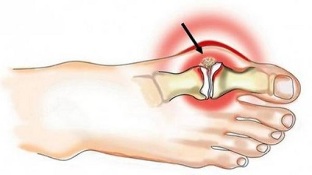Arthritis and osteoarthritis are quite common today. Many people confuse these diseases because of the similarities in their manifestation. However, in reality, both diseases are very different from each other. You can only understand the difference between diseases if you study their characteristics.
Types of pathology

It is impossible to define joint disease based on pain alone. Almost every disease of the musculoskeletal system is accompanied by pain.
The following diseases are most common:
- Arthritis,caused by inflammation of the joint surface. This inflammation occurs for various reasons. The primary form develops against the background of numerous diseases of gout, septic and rheumatic nature.
Secondary form can develop after systemic lupus erythematosus, borreliosis, arthropathy.
- Osteoarthritis,causing destruction of the cartilage and the part of the bone below.
Primarily usually develops for no reason. It usually manifests in older people and affects the surface of large symmetrical bone joints.
The secondary form of the disease occurs after suffering a serious illness. Often, the development of this form is caused by a genetic predisposition.
Inflammation of large bone joints (shoulder, knee) is often caused by overweight, intense physical activity, past trauma, and endocrine diseases.- Arthropathy is a violation of the integrity of the joints as a result of transmitted complex diseases.
- Tendonitis is an inflammatory process that occurs in the tendons.
- Enthesitis - structural changes at the junction of soft tissue with bone.
- Bursitis is a lesion of the bursa.
- Capsulitis - inflammation and violation of the integrity of the joint capsule.
How to distinguish arthrosis of different severity from arthritis? You need to know that arthritis and osteoarthritis have different nature of manifestation, which determines the treatment of arthritis.
Feature difference

How is arthritis different from osteoarthritis? Signs that indicate the presence of a certain disease. The signs of arthritis and osteoarthritis of the knee joint are specific.
What is osteoarthritis? A chronic disease that is destructive in itself. The peculiarity of the disease is that it affects the cartilage and is irreversible.
The disease most commonly affects people of both sexes over the age of 60. That is, arthrosis of the knee joint is considered a disease during which there is a mass destruction of cartilage. A large joint, such as the ankle, is affected first. Special attention should be paid to its treatment.
When rheumatoid arthritis touches the hands or feet, the inflammation is found in several bone joints at the same time. The main difference between arthrosis and arthritis is that the second disease is accompanied by inflammation of large bone joints - knees, shoulders.
Arthritis has a number of secondary symptoms. It especially causes swelling of the joints, redness around them. In addition, the patient has a fever, blocking motor functions. One of the factors that can cause the disease is: allergies, infectious diseases, metabolic disorders and trauma.
In the case of an inflammatory process, a person's motor activity is impaired. In particular, the range of motion is significantly reduced. This restriction applies to movements performed independently and to those for which the person needs help.
Inflammation affects either one joint or several at a time. Usually, this phenomenon is accompanied by pain without a clear place of their localization, and the joint surface of the ankle joint or foot remains intact.
It is worth remembering that the main danger of this disease is that changes occur not only in the bone tissues, but also in other organs, for example, in the digestive, visual and excretory organs. The changes can also affect the dermis.
The disease affects people of any age, however, the disease is most often diagnosed in women aged 35-50 years.

As for pain, arthritis accompanies it all the time. In the presence of osteoarthritis, the destruction of bone tissue is usually asymptomatic, without causing pain, so the patient does not notice it.
In the first case, the disease manifests itself in some way. It is accompanied by weakness of the body, sometimes psoriasis. In the second case, all inflammatory changes occur without external signs.
Arthritic inflammation is manifested externally by swelling of the soft tissues. They are also characterized by joint paralysis. Changes of different nature occur smoothly and are practically not manifested. However, they are characterized by a specific “dry” creaking that occurs as a result of joint wear.
What is the difference between arthritis and osteoarthritis? Others provoke cartilage destruction, and rheumatic disease manifests as inflammation of the bone tissue. It is these signs that are the main distinguishing features of arthritis that has affected a person or osteoarthritis.
Difference in symptoms
How is osteoarthritis of different origins different from arthritis? Osteoarthritis and arthritis differ in the symptoms of the disease. Knowing them is very important because symptoms and treatment are interrelated.
Arthritis and osteoarthritis of the knee show similar symptoms. However, you can still distinguish them. Arthritis and arthrosis of the knee joint and others are manifested by severe pain. However, the nature of the pain is different. With osteoarthritis, the patient feels pain on the move or due to a large load on the knees. It is painful, the attack lasts a long time.
The first stage is characterized by mild pain, so the disease is often detected only during diagnosis.
In the next stage, the patient feels pain even under light load conditions.

In the third stage of its development, the disease is considered neglected. Pain can occur even when there is no movement at all. After changing the position of the joint to a comfortable one, the pain subsides.
Hand, shoulder or hip disease is characterized by acute pain that does not go away at all. An attack of pain often begins early in the morning. The symptoms of arthritis and osteoarthritis are different. The presence of cramping in them you can understand whether arthritis or osteoarthritis has affected the joints. If it is heard, it means that another disease has affected the bone joint.
Osteoarthritis of the knee or other large joints may be accompanied by contraction if the cartilage layers are destroyed and if there is direct bone contact.
The disease negatively affects the mobility of one affected joint. For example, osteoarthritis of the knee is accompanied by pain in the legs. Arthritic arthritis or another type of arthritis occurs with a feeling of stiffness throughout the body.
How is arthritis different from osteoarthritis? In addition, gonarthrosis runs without external swelling, but with an external change in the joints.
Osteoarthritis or arthritis affects the joints: what's the difference? In addition to the main symptoms, arthritis is accompanied by hyperthermia, eye inflammation, excessive sweating and weakness.
Diagnostic Differences
It is possible to diagnose arthritis of various origins and arthrosis only by determining the cause of the development of this disease. Treatment is started only after determining the level of disease development activity. In addition, during the diagnosis, the attending physician must make a prognosis to prevent a bad outcome.
Treatment of osteoarthritis in different stages and arthritis begins only after a detailed diagnosis.

The complex of medical tests consists of general clinical laboratory research, X-ray imaging, microscopy and bacteriological research.
Diseases of different origins differ in the results of the performed analyzes.
If arthritis and osteoarthritis are not treated immediately, it will become impossible to cure. In addition, systemic prevention of arthritis and osteoarthritis should be implemented. Do you want to get rid of arthritis and osteoarthritis with effective treatment? Get a major exam that includes MRI and arthroscopy.
An informative method that allows you to recognize the difference in the manifestations of arthritis from osteoarthritis of the knee joint is X-ray.
Differences in treatment
How are arthritis and osteoarthritis treated? The symptoms and treatment of the disease are interrelated. The treatment for osteoarthritis is the same, but there are some differences. From the point of view of medicine, diseases are different, so the treatment of arthrosis and arthritis is safe.
How to treat osteoarthritis and rheumatoid arthritis? Complex therapy will help cure any disease. In both cases, patients with osteoarthritis and arthritis are prescribed treatment, including medication (medication prescribed by a doctor). Physiotherapy, ie physiotherapy exercises, is prescribed, which is especially important for patients with arthritis or a form of osteoarthritis of the knee joint, because it helps speed up treatment. For arthritis and osteoarthritis of the joints, treatment involves a child, whose menu varies.
Those who want to improve their health "without drugs" often carry out treatment with various folk remedies.
Diseases can last long enough and become chronic. Despite the reasons for their appearance, they cause the development of complications. Therefore, patients must be constantly or for a long time under medical supervision and undergo rehabilitation, whose program was developed especially for them.
In order to avoid the development of the disease, special attention should be paid to the prevention of the disease.

- It is first necessary to treat all diseases of the musculoskeletal system in time and to undergo comprehensive rehabilitation after injuries.
- Second, you should limit or at least dose physical activity, eat properly, and monitor your weight.
- Third, you should systematically consult a doctor to determine the presence and correct bone deformities in a timely manner.
So the difference between these two diseases is significant. It is manifested by symptoms, signs and causes of discomfort. The nature of the course is also specific. In the absence of timely qualified help, inflammatory processes in bone tissue and cartilage can cause complications.
Prevention will help to avoid the development of this or that disease, to which special attention should be paid.



































